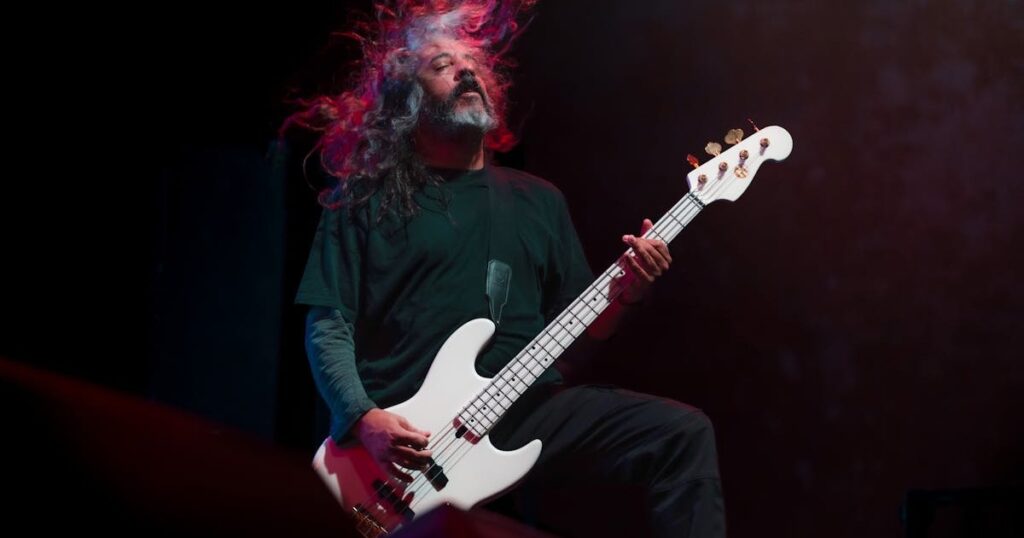Key Takeaway: Creating an electric guitar drawing is not only an artistic journey, but it also allows you to appreciate the intricacies and design of this iconic instrument. By following each step carefully, you can produce a unique and vibrant representation that reflects your passion.
Drawing an electric guitar is not just about creating a beautiful visual representation of a musical instrument. It’s also about showcasing the intricate details and design elements that make up this iconic piece of equipment.
Whether you’re a local resident, cultural enthusiast, or simply someone curious about guitars, learning how to draw an electric guitar can be both fun and rewarding.

In this article, we’ll guide you through the process of drawing an electric guitar step by step. From the neck to the body, we’ll cover all the important aspects to help you create a realistic and accurate portrayal of this beloved instrument.
Draw the neck of the guitar.
The first step in drawing an electric guitar is to outline its shape and structure. Start by drawing a horizontal line near the top of your paper for the neck of the guitar. This line will serve as your guide for positioning other elements, such as frets and strings.
Next, draw a long, narrow rectangle atop the horizontal line to represent the neck. The width of this rectangle will depend on how thick or thin you want your guitar’s neck to be. Keep in mind that electric guitars typically have thinner necks compared to acoustic guitars.
Now, add six vertical lines across the width of the rectangle to create frets. These lines should be evenly spaced with equal distances between each one. You can also add markers at specific points along the fretboard, such as dots for the third, fifth, seventh, ninth, and twelfth frets.
Lastly, add two small circles at the top of the neck to represent tuning pegs. These will hold the strings in place and allow you to tune your guitar.
Add the head of the electric guitar and some smaller details
The head of an electric guitar is where all the magic happens. This is where you’ll find the tuning machines, truss rod cover, and other important components that help produce its unique sound.
To draw the head of your electric guitar, start by drawing a curved line connecting from one end of the neck to another. Then, draw a rectangle or square shape above this line to represent the headstock.

The shape and size of the headstock will vary depending on the type of electric guitar you’re drawing, but it usually has a slight curve or angle to it.
Next, tuning machines are added by drawing six small circles along the top edge of the headstock. These should be evenly spaced with equal distances between them. You can also draw a curved line near the bottom of the headstock to represent the truss rod cover.
Now, draw some smaller details.
No electric guitar is complete without its trademark pickups and knobs. These components are essential in producing different tones and sounds from your guitar.
To draw pickups, start by drawing two rectangles at each end of the neck for single-coil pickups or humbuckers. These can vary in size and shape, so feel free to experiment and make them your own.
Next, draw two small circles on either side of the neck for volume and tone knobs. You can also add a switch near the pickup selector for additional control over your guitar’s sound.
Draw the final details for your electric guitar.
Now, it’s time to add some finishing touches to your drawing. Start by adding strings along the fretboard by drawing thin lines from each tuning peg down to the bridge of the guitar. Next, draw the body of the guitar by outlining its unique shape, whether it’s a classic Stratocaster or Les Paul design.

Then, add any additional details, such as a pickguard, tremolo bar, or strap buttons. These small elements can add character to your drawing and make it more realistic.
Now, finish off with some colour for this electric guitar
After completing all the necessary details of your electric guitar drawing, you can now add some colour to bring it to life. You can use different shades of black and grey for a classic look or experiment with bold colours for a more modern design.
Don’t be afraid to get creative with your colour choices and try out different combinations. After all, an electric guitar is not just about its sound but also its visual appeal.
FAQs:
Can I draw the electric guitar in a different position?
Absolutely! You can draw the guitar in any position or angle you prefer. Just remember to keep the proportions and details accurate.
Do I have to follow specific measurements to draw the frets and strings?
Not necessarily. As long as they are evenly spaced and proportionate to the size of your guitar, you can adjust them according to your preference.
Is it necessary to add all the smaller details like pickups, knobs, and switches?
While these components may seem small, they play a crucial role in an electric guitar’s functionality and design. Adding them will make your drawing more realistic and complete.
Conclusion: drawing of an electric guitar
Drawing an electric guitar is not only a creative exercise but also a way to connect with the rich culture of music. By following the steps outlined above, you can develop your artistic skills while exploring the fascinating details that make each guitar unique.
Whether you’re a beginner or an experienced artist, taking the time to accurately represent an electric guitar can deepen your appreciation for this iconic instrument. So grab your pencil, unleash your imagination, and bring your own vision of an electric guitar to life! Happy drawing!
